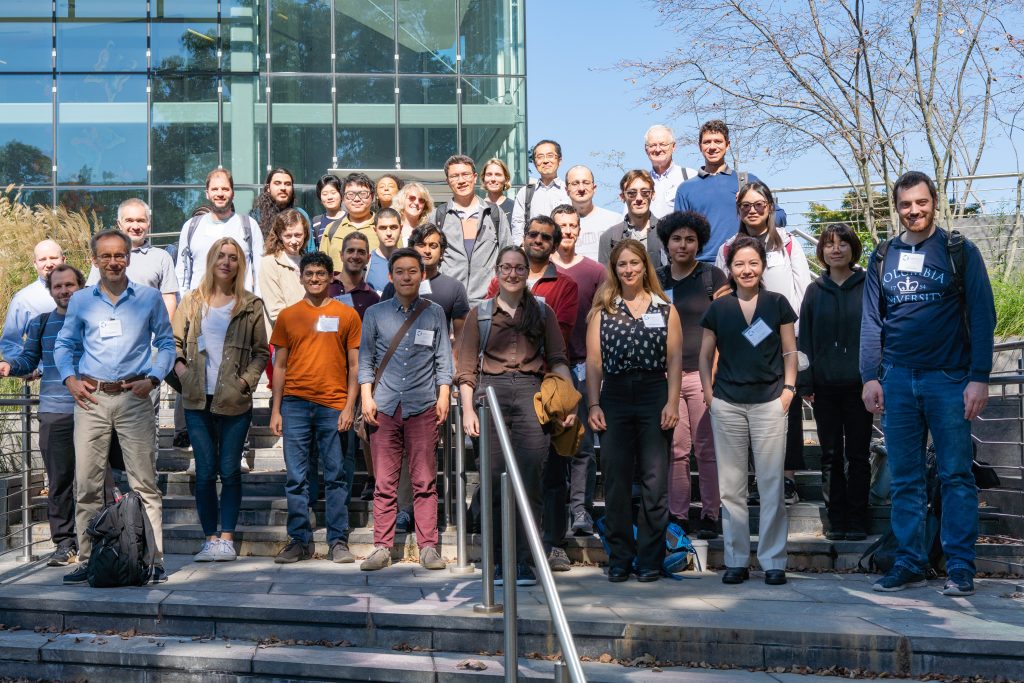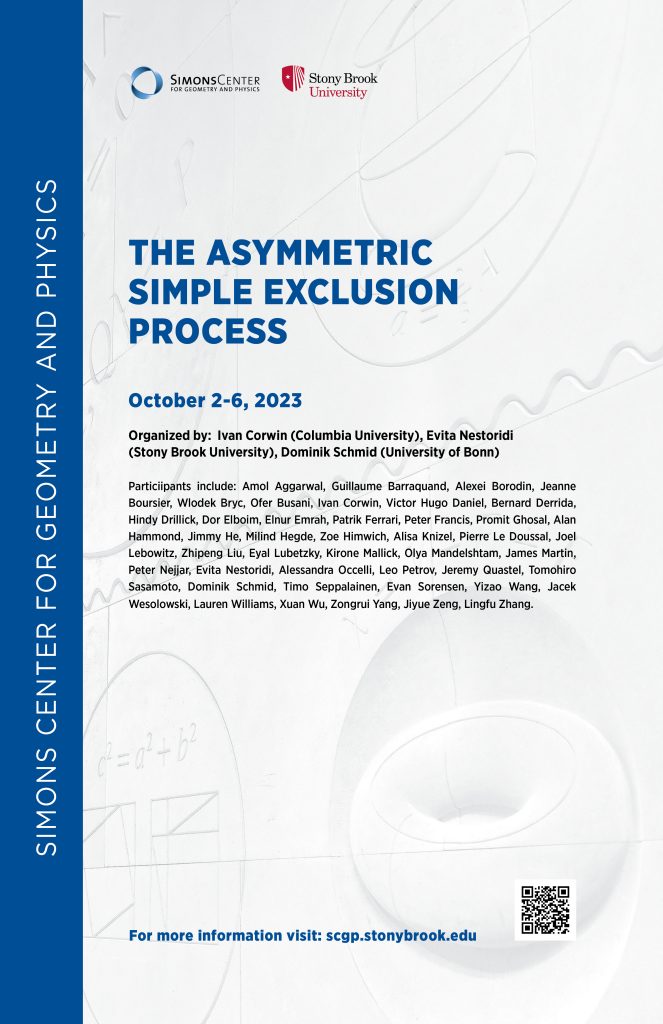Attendee ListScheduleDANFORDS SHUTTLEView Videos
Organized By:
- Ivan Corwin, Columbia University
- Evita Nestoridi, Stony Brook University
- Dominik Schmid, University of Bonn
The asymmetric simple exclusion process (ASEP) is a central model in research on integrable probability and interacting particle systems. It is one of the most prominent examples of a stochastic interface growth model, which gives under a suitable weakly scaling rise to a solution of the KPZ equation; see surveys by Corwin [10, 11], and the seminal work [17] by Kardar, Parisi and Zhang for an overview. Other integrable models with similar properties include the stochastic six vertex model, log-gamma and O’Connell-Yor polymers. The particular case of the open ASEP is defined as the following interacting particle system. Particles occupy sites in a finite segment {1, …, N}for some N ∈ N, and they jump left at rate q and right at rate 1. Moreover, particles are inserted into site 1 at rate α and removed from there at rate γ, while at site N insertion occurs at rate δ and removal at rate β. All moves that violate the rule of at most one particle per site at a given time are excluded. In recent years, various breakthroughs in the study of asymmetric exclusion processes could be achieved.
Talk Schedule
| Time | Title | Speaker | Location |
| 9:00am | Breakfast | N/A | SCGP Cafe |
| 9:30am | Convergence of ASEP to the KPZ fixed point | Jeremy Quastel | SCCP 102 |
| 10:00am | The ASEP speed process | Promit Ghosal | SCGP 102 |
| 10:30am | Coffee Break | N/A | SCGP Cafe |
| 11:00am | Stationary measures in last passage percolation | Guillaume Barraquand | SCGP 1012 |
| 11:30am | The stationary horizon as the central multi-type invariant measure in the KPZ universality class | Evan Sorenson | SCGP 102 |
| 12:00pm | Lunch | N/A | SCGP Cafe |
| 1:30pm | The KPZ equation limit of sticky Brownian motion | Hindy Drillick | SCGP 102 |
| 2:00pm | The scaling limit of the geodesic in the directed landscape and continuum directed random polymer under upper tail conditioning | Milind Hedge | SCGP 102 |
| 2:30pm | Formulas for Macdonald polynomials via interacting particle systems | Olya Mandelshtam | SCGP 102 |
| 3:30pm | Tea Time | N/A | SCGP Cafe |
| Time | Title | Speaker | Location |
| 9:00am | Breakfast | N/A | SCGP Cafe |
| 9:30am | From the KPZ equation to the directed landscape | Xuan Wu | SCGP 102 |
| 10:00am | Pinched-up periodic KPZ fixed point | Zhipeng Liu | SCGP 102 |
| 10:30am | Coffee Break | N/A | SCGP Cafe |
| 11:00am | Limit profile of the ASEP with one open boundary | Jimmy He | SCGP 102 |
| 11:30am | Cutoff of the colored ASEP and a systematic Metropolis scan | Lingfu Zhang | SCGP 102 |
| 12:00pm | Group Photo | N/A | SCGP 102 |
| 12:00pm | Lunch | N/A | SCGP Cafe |
| 1:15pm | A Characterization for the Airy Line Ensemble | Amol Aggarwal | SCGP 102 |
| 2:30pm | SBU Math Colloquium | Alexei Borodin | SCGP 103 – Auditorium |
| 3:30pm | Tea Time | N/A | SCGP Cafe |
| Time | Title | Speaker | Location |
| 9:00am | Breakfast | N/A | SCGP Cafe |
| 9:30am | Rhombic staircase tableaux and Koornwinder polynomials | Lauren Williams | SCGP 102 |
| 10:00am | Weighted random Motzkin paths and the stationary distribution for an open Asymmetric Simple Exclusion Process | Woldek Bryc | SCGP 102 |
| 10:30am | Coffee Break | N/A | SCGP Cafe |
| 11:30am | Current fluctuations for symmetric processes | Tomohiro Sasamoto | SCGP 102 |
| 12:00pm | Lunch | N/A | SCGP Cafe |
| 1:30pm | Decorrelation of the KPZ fixed point from the flat initial condition | Ofer Busani | SCGP 102 |
| 2:00pm | Infinitesimal generators of quadratic harnesses – an algebraic approach | Jacek Wesolowski | SCGP 102 |
| 2:30pm | Universality for multicomponent stochastic systems | Alessandra Occelli | SCGP 102 |
| 3:00pm | Exact solutions of the macroscopic fluctuation theory for the symmetric exclusion process | Kirone Mallick | SCGP 102 |
| 3:30pm | Tea Time | N/A | SCGP Cafe |
| 4:00pm | Exact Solution of a Lifted Asymmetric Exclusion Process | Fabian Essler | SCGP 102 |
| 6:00pm | Banquet Dinner | N/A | SCGP Cafe |
| Time | Title | Speaker | Location |
| 9:00am | Breakfast | N/A | SCGP Cafe |
| 9:30am | TASEP with a moving wall | Patrik Ferrari | SCGP 102 |
| 10:00am | On the computation of limits of stationary measures of open ASEP | Yizao Wang | SCGP 102 |
| 10:30am | Coffee Break | N/A | SCGP Cafe |
| 11:00am | Tagged particles, voter models and fractional Gaussian noise | Alan Hammond | SCGP 102 |
| 11:30am | Large deviations for diffusion in random media: integrable crossover from macroscopic fluctuation theory to weak noise KPZ equationy | Pierre Le Doussal | SCGP 102 |
| 12:00pm | Lunch | N/A | SCGP Cafe |
| 1:00pm | The second class particle shock process in TASEP | Peter Nejjar | SCGP 102 |
| 1:30pm | Ergodic stationary measures of the Kardar-Parisi-Zhang equation | Timo Seppäläinen | SCGP 102 |
| 2:00pm | Della Pietra Lecture Series: Technical Talk for Faculty by Ian Stewart | N/A | SCGP 103 |
| 3:30pm | Tea Time | N/A | SCGP Cafe |
| Time | Title | Speaker | Location |
| 9:00am | Breakfast | N/A | SCGP Cafe |
| 9:30am | Askey-Wilson signed measures and open ASEP in the shock region | Zongrui Yang | SCGP 102 |
| 10:00am | The influence of edges in first-passage percolation on Z^d | Dor Elboim | SCGP 102 |
| 10:30am | Coffee Break | N/A | SCGP Cafe |
| 11:00am | Colored Interacting Particle Systems on the Ring: Stationarity from Yang-Baxter | Leonid Petrov | SCGP 102 |
| 12:00pm | Lunch | N/A | SCGP Cafe |
| 3:30pm | Tea Time | N/A | SCGP Cafe |



